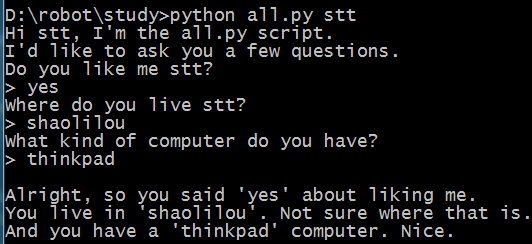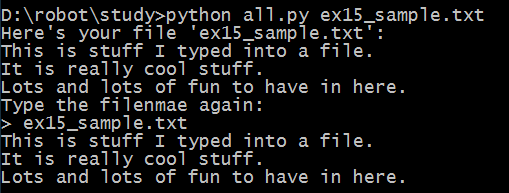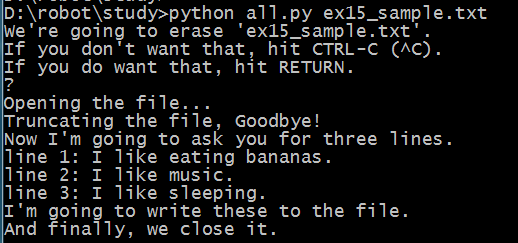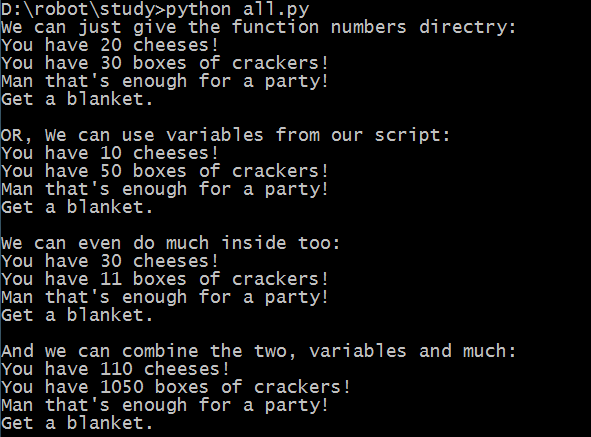习题11:提问
-- 接受键盘的输入 raw_input
input() 和 raw_input() 有何不同?
input() 函数会把你输入的东西当做 Python 代码进行处理,这么做会有安全问题,你应该避开
这个函数。
代码:
print "how old are you?",
age = raw_input()
print "How tail are you?",
height = raw_input()
print "how much do you weight?",
weight = raw_input()
print "So, you're %r old, %r tall and %r heavy." % (
age, height, weight)
结果:

习题12:提示别人
代码:
age = raw_input("How old are you? ")
height = raw_input("How tall are you? ")
weight = raw_input("How much do you weight? ")
print "So, you're %r old, %r tall and %r heavy." % (age, height, weight)
结果:

习题13:参数、解包、变量
-- 将变量传递给脚本的方法(所谓脚本,就是你写的 .py 程序),涉及“参数”
-- import 将python已有的功能引入脚本直接使用
-- argv:参数变量
-- 解包:script, first, second, third = argv 把argv中的东西解包,将所有的参数一次赋予左边的变量名
-- argv 和 raw_input() 有什么不同?
不同点在于用户输入的时机。如果参数是在用户执行命令时就要输入,那就是 argv,如果是在脚本运行过程中需要用户输入,那就使用 raw_input()。
代码:
from sys import argv
script, first, second, third = argv
print "The script is called:", script
print "Your first variable is:", first
print "Your second variable is:", second
print "Your third variable is:", third
结果:

习题14:提示与传递
代码:
from sys import argv
script, user_name = argv
prompt = '> '
print "Hi %s, I'm the %s script." % (user_name, script)
print "I'd like to ask you a few questions."
print "Do you like me %s?" % user_name
likes = raw_input(prompt)
print "Where do you live %s?" % user_name
lives = raw_input(prompt)
print "What kind of computer do you have?"
computer = raw_input(prompt)
print '''
Alright, so you said %r about liking me.
You live in %r. Not sure where that is.
And you have a %r computer. Nice.
''' % (likes, lives, computer)
结果:

习题15:读取文件
-- 涉及两个文件,一个脚本文件.py文件,另一个是ex15_sample.txt
第二个文件内容:
This is stuff I typed into a file.
It is really cool stuff.
Lots and lots of fun to have in here.
-- open() 打开文件 返回的是一个“file object”
-- read() 读取文件内容
代码:
from sys import argv
script, filename = argv
txt = open(filename)
print "Here's your file %r:" % filename
print txt.read()
print "Type the filenmae again:"
file_again = raw_input("> ")
txt_again = open(file_again)
print txt_again.read()
结果:

习题16:读写文件
-- close 关闭文件
-- read 读取文件内容
-- readline 读取文本文件中的一行
-- write(stuff) 将stuff写入文件
代码:
from sys import argv
script, filename = argv
print "We're going to erase %r." % filename
print "If you don't want that, hit CTRL-C (^C)."
print "If you do want that, hit RETURN."
raw_input("?")
print "Opening the file..."
target = open(filename, 'w')
print "Truncating the file, Goodbye!"
target.truncate()
print "Now I'm going to ask you for three lines."
line1 = raw_input("line 1: ")
line2 = raw_input("line 2: ")
line3 = raw_input("line 3: ")
print "I'm going to write these to the file."
target.write(line1)
target.write('\n')
target.write(line2)
target.write('\n')
target.write(line3)
target.write('\n')
print "And finally, we close it."
target.close()
结果:

习题17:更多文件操作
-- exists() 判断文件是否存在,存在,继续执行;不存在,新建文件再继续执行
代码:
from sys import argv
from os.path import exists
script, from_file, to_file = argv
print "Copying from %s to %s" % (from_file, to_file)
#we could do these two on one line too, how?
in_file = open(from_file)
indata = in_file.read()
print "The input file is %d bytes long" % len(indata)
print "Does the output file wxist? %r" % exists(to_file)
print "Ready, hit RETURN to continue, CTRL-C to abort."
raw_input()
out_file = open(to_file, 'w')
out_file.write(indata)
print "Alright, all done."
out_file.close()
in_file.close()
结果:

习题18:命名、变量、代码、函数
函数可做三洋事情:
1、给代码片段命名,就跟“变量”给字符串和数字命名一样
2、可以接受参数,就跟脚本接受argv一样
3、通过使用#1和#2,可以创建“微型脚本”或者“小命令”
介绍:
def:定义
函数名:可以随意取,最好能体现出函数的功能来,注意命名规范!不可重复
参数:放在圆括号内
格式:def 函数名称 (参数-多个参数以“,”隔开):
函数内容 开始编写前缩进4个空格
函数可以接收参数,也可以不接收参数
运行/调用函数,函数名后紧跟(参数-可有可无,可多个)
代码:
# this one is like your scripts with argv
def print_two(*args):
arg1, arg2 = args
print "arg1: %r, arg2: %r" % (arg1, arg2)
# ok, that *args is actually pointless, we can just do this
def print_two_again(arg1, arg2):
print "arg1: %r, arg2: %r" % (arg1, arg2)
# this just takes one argument
def print_one(arg1):
print "arg1: %r" % arg1
# this one takes no arguments
def print_none():
print "I got nothin'."
print_two("Zed", "Shaw")
print_two_again("Zed", "Shaw")
print_one("First!")
print_none()
结果:

习题19:函数和变量
代码:
def cheese_and_crackers(cheese_count, boxes_of_crackers):
print "You have %d cheeses!" % cheese_count
print "You have %d boxes of crackers!" % boxes_of_crackers
print "Man that's enough for a party!"
print "Get a blanket.\n"
print "We can just give the function numbers directry:"
cheese_and_crackers(20, 30)
print "OR, We can use variables from our script:"
amount_of_cheese = 10
amount_of_crackers = 50
cheese_and_crackers(amount_of_cheese, amount_of_crackers)
print "We can even do much inside too:"
cheese_and_crackers(10 + 20, 5 + 6)
print "And we can combine the two, variables and much:"
cheese_and_crackers(amount_of_cheese + 100, amount_of_crackers + 1000)
结果:

习题20:函数和文件
-- 更多文件操作 seek() readline()
代码:
from sys import argv
script, input_file = argv
def print_all(f):
print f.read()
def rewind(f):
f.seek(0)
def print_a_line(line_count, f):
print line_count, f.readline()
current_file = open(input_file)
print "First let's print the whole file:\n"
print_all(current_file)
print "Now let's rewind, kind of like a tape."
rewind(current_file)
print "Let's print three lines:"
current_line = 1
print_a_line(current_line, current_file)
current_line = current_line + 1
print_a_line(current_line, current_file)
current_line = current_line + 1
print_a_line(current_line, current_file)
结果:




